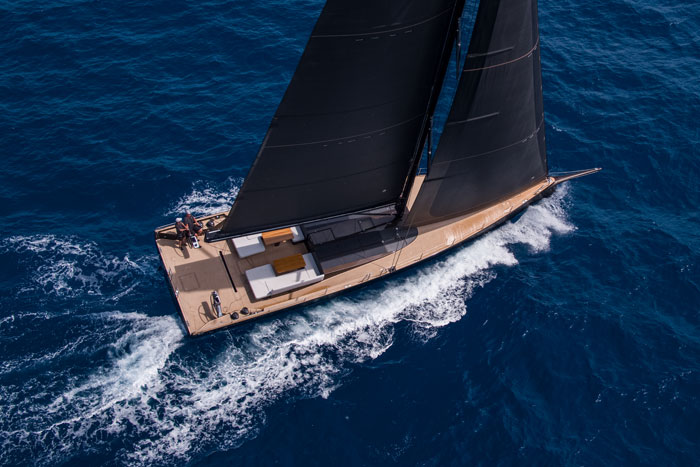
Launched in 2022, the Baltic 68 Pink Gin Verde might point the way to the future. Built in hybrid (50% flax) fibre, this eco-conscious ‘Café Racer’ performed well at Les Voiles de St-Tropez. Its most notable feature, though, is what’s missing – not just the runners, there’s no backstay

Baltic Yachts was founded with a mission to make sailing boats faster, stiffer, lighter and better. They’ve pursued that original goal relentlessly ever since
Fifty years ago in Finland five young men shared a controversial idea and an ambitious plan. They quit their jobs at Nautor and set out to create a new style of offshore cruiserracer – lighter, stiffer and faster than almost anything else on the market.
‘We just got together one day and the idea came up,’ says Per-Göran “PG” Johansson, one of the five founding fathers of Baltic Yachts back then and still one of its directors today. ‘We were not alone thinking “light is better” but most boatyards and naval architects favoured heavier designs. Some of our competitors published studies for marketing purposes arguing that heavy was better. One of their claims was “heavy does not stop in waves due to the inertia of the mass”. Another was “the client gets more kilos for his money”. We remained convinced and carried on with our lightweight, hi-tech way.’
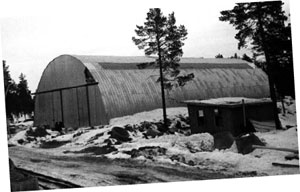
Above: it all started here in 1973. This first shed has served the yard well for 50 years
Below: three of Baltic Yachts’ five founding fathers inside that shed in 1974: (L-R) Tor Hinders, PG Johansson and Nils Luoma
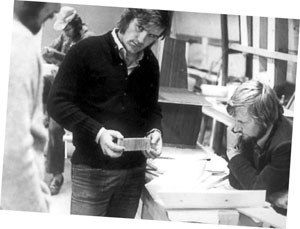
History soon proved Johansson and his colleagues to be absolutely correct and the company they founded became a world leader in the production of large, high-performance sailing yachts. Before any of it could happen, first they had to clear a patch of pine forest at Bosund near Jakobstad and build a shed in which to do it.
Still in use as a joinery workshop, that first shed is finally about to be decommissioned along with the whole facility that grew up around it. This year, Baltic Yachts is moving all operations to Jakobstad where a new state-of-the-art building will more than double the size of its existing waterfront location.
There’s a world of difference between the series-produced Baltics of the 1970s and the full-custom superyachts that have become the yard’s primary focus alongside its ongoing small-series, semicustom production. However, from the first Baltic 46 Diva (now Queen Anne) all the way to its current projects via some of the most advanced sailing yachts in each of the last three decades, the core DNA is arguably unchanged. ‘Baltic Yachts is still very much true to its original values,’ Johansson says. ‘We started as a series production yard but with more flexibility built in than most competitors, using hi-tech methods to achieve better sailing performance and handling characteristics. With time we moved over more and more to full custom projects, which required changes in our approach.
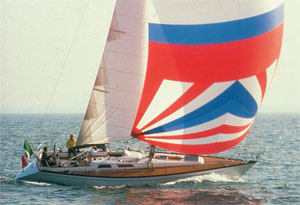
Above: The Baltic 38DP, built 1982-1989, was among the first sailing yachts designed with a computer and one of the first with a double berth under an aft cockpit
‘The projects became more individual in concept, in styling and in materials and methods used. In that process you lose some of the things that originally earned your company its reputation. However, even our cruising projects have been very hi-tech and in that sense they’ve followed our original philosophy, “lighter is faster and better”. Some of the high-performance projects challenged us to take technology much further, increasing our know-how and potential.’
Eagerness to embrace technology prompted the founding of Baltic Yachts in the first place. Johansson was project manager of the Swan 65 when he tried and failed to convince his managers that it could be built lighter, stiffer and better using sandwich construction with unidirectional fibres instead of a single laminate with woven rovings. The five who left Nautor – boatbuilders Jan-Erik Nyfelt and Nils Luoma, purchasing manager Ingmar Sundelin, designer Tor Hinders and Johansson – became the nucleus of Baltic Yachts.
Baltic Yachts – major milestone boats 1974-2022
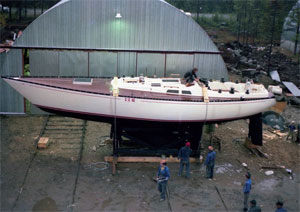
The very first boat: Baltic 46 Diva (now Queen Anne) was launched in 1974
1974
Baltic 46
Ahead of its time: tank tests, sandwich construction, unidirectional fibres, balanced spade rudder, epoxy bonded teak deck…
1977
Baltic 39
Most popular model, 74 in six years. From 1980, one of the first yachts to have computer-generated VPP
1979
Baltic 51
Notable for interior design innovations. First double-berth cabin under an aft cockpit, slanted bulkheads for optimal use of space
1982
Baltic 80 Midnight Sun
Baltic Yachts’ first maxi racer and one of the first maxis with full glassfibre composite construction
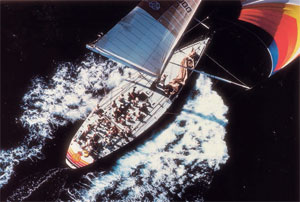
Baltic 80 Midnight Sun, one of the first maxi yachts built in fibreglass composites, 1982
1985
Baltic 43 Bully
The first offshore sailing yacht in the world built entirely with epoxy resin
1996
Baltic 67 Aledoa
The first cruising yacht built entirely in pre-preg carbon
1996
Baltic 87 Anny
First Baltic with a lifting keel, complex hydraulics and push-button sail controls
1997
Baltic 70 Vittfarne
First Baltic yacht to combine classic appearance with hitech construction and modern hydrodynamics
1997
Baltic 70 Loftfari
The first yacht with a fully fitted interior built entirely in prepreg carbon and Nomex honeycomb, all invisible under the teak veneer finish
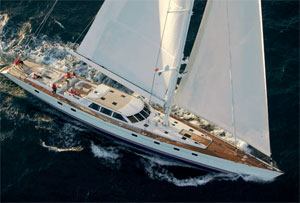
First modern ‘super cruiser’: Baltic 141 Canica was launched in 2003 with complex systems and very light displacement
2000
Baltic 78 Super Baltic 5
Canting keel with its entire mechanism under the cabin sole; 3.5kts faster than the same yacht with a fixed keel
2002
Baltic 147 Visione
The first superyacht capable of planing at 30kts. Packed with unique innovations, ultra-light displacement (105T) and almost literally no expense spared
2003
Baltic 141 Canica
A very complex build and fitout with hi-tech materials, construction techniques and systems. The first Baltic ‘super cruiser’
2011
Baltic 197 Hetairos
Largest carbon composite sailing yacht in the world at 221ft LOA. Classic look, superb finish. Hi-tech build and hydrodynamics
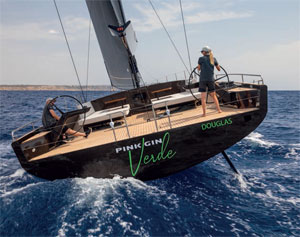
Alongside its big custom projects Baltic still builds semi-custom boats like the current Baltic 68
2017
Baltic 175 Pink Gin
The largest full carbon sloop in the world to date. Unique fold-down, through-hull platforms in the saloon and owner’s suite
2019
Baltic 142 Canova
First DSS foil on an ocean cruising superyacht. First hybrid drive with full regeneration. Advanced composite engineering. A giant leap into the future
2022
Baltic 68 Pink Gin Verde
First Baltic yacht built with 50% flax fibre. Advanced electric/hybrid propulsion, super efficient systems
‘They had a strong belief in themselves, courage to swim upstream and test new ideas,’ Baltic Yachts’ marketing manager Elisabet Holm explains. ‘They all had a passion for boats, a strong driving force to learn new things and research technology, and they were always ready to meet new challenges.’
The original Baltic 46 was far ahead of its time. At a time when nearly all new designs simply relied on the naval architect’s eye, experience and intuition, several different hull models were tank tested across a range of speeds, at various heel and leeway angles before the design of the 46 was finalised and only then was it built. It had a balanced spade rudder and solid rod rigging, which were then used only on hi-tech racing yachts and its teak deck was laid with epoxy resin. But the hull laminate itself was the key innovation.
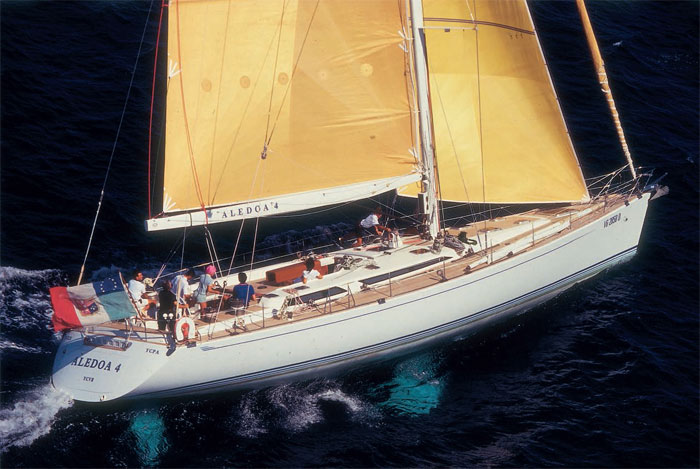
The Baltic 67 Aledoa was the first cruiser-racer ever built in pre-preg carbon fibre, launched in 1996
‘In those days most yards building larger yachts used woven rovings with fibres bent, not straight, hence not structurally optimal and they also resulted in resin concentration,’ Johasson explains. ‘You could see the roving patterns on the surface, due to resin shrinking, so before applying the rovings they used several layers of chopped mat, which has very low structural value, especially on larger yachts, but added a lot of weight.
‘We used a very thin surface cloth and the rest of the laminate was unidirectional fibres, oriented in the direction of the stresses and perfectly straight, hence stronger and stiffer. The fibres we used did not create resin concentration so there was less print-through on the hull surface. Unidirectional does not build up thickness like woven rovings so we used them with a core material in sandwich construction. This achieved much higher panel stiffness than a single laminate and gave us more flexibility for panel sizes.’
End grain balsa was the core for the 46 but Baltic soon switched to foam cores with a variety of densities and strengths. Carbon fibre was used from 1979, initially in rudder posts, beam tops and to reinforce highstress areas of the hull where extra stiffness was needed. As stabilised foams for high-temperature cures and then Nomex for pre-preg carbon construction became available, Baltic pioneered the use of those materials.
Baltic Yachts’ early achievements belie the fact that it faced strong headwinds right from the start. 1973 was a bad year to launch a new brand of sailing yachts, with the global oil crisis looming. The yachting industry as a whole was hit hard and by 1977 Baltic had to seek outside investment to stay in business. Ironically that same year saw their first major commercial success, selling 12 Baltic 39s at the Hamburg Boat Show, which was unheard of at the time.
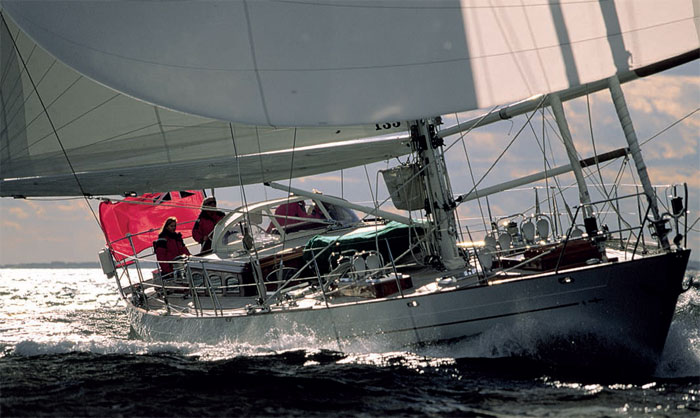
Launched in 1997, the Baltic 70 Vittfarne heralded a new type of performance cruiser that combines traditional styling with hi-tech construction and modern hydrodynamics
Hollming, a Finnish shipbuilder, acquired Baltic. Two of the founders, Nils Luoma and Ingmar Sundelin, quit but the takeover turned out to be a positive move. Hollming provided stability and investment to help Baltic grow. A huge production hall was built, funds were provided for new model development and marketing.
An unusual aspect of Baltic Yachts that undoubtedly worked in its favour was the dual role of Johansson. It’s rare that the technical guru of a major boatbuilder is also its head of sales and marketing, yet he combined both jobs with great success for 40 years. Even now, though officially retired, he still frequently offers a guiding hand in the development of new projects and the current EVP, Henry Hawkins, describes him as ‘an unbelievably useful sounding board and wise head’.
Baltic’s in-house designer Tor Hinders made his mark by changing the way boats are fitted out down below. His stand-out innovation, which was met with hostility when introduced in 1979 on the Baltic 51 but has since been copied by almost every sailing yacht builder in the world, was to put a double-berth cabin under an aft cockpit.
Another key factor in Baltic Yachts’ early success was its partnership with the Canadian naval architects C&C Design, whose chief engineer Rob Ball was among the first in the industry to start using computers. From 1980 he supplied VPP – polar curves and tables of numbers – for the Baltic 39, 51 and 37, with detailed instructions on how to use them. Despite being generated by 2D computing (as 3D models were not yet available), Johansson says those first VPP numbers were accurate and useful.
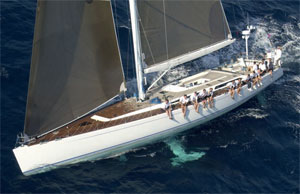
The 78ft Super Baltic 5, a major engineering challenge in 2000. The entire canting keel mechanism was fitted under the saloon sole
The yard was quick to develop its own computing expertise. ‘As soon as programmable calculators and then the Epson HX-20 computer became available we saw their potential and started to use them,’ Johansson says. ‘There was no software so we did our own coding.’ By the early 1980s they were already using these tools for displacement, flotation and trim calculations, laminate design and rating optimisation.
A huge quantity of data has been compiled since then and the initially simple programs have evolved into a sophisticated suite of software that enables the technical team to make extremely detailed weight and load calculations for the hull and rig of any new design, study engine power, prop pitch and range for electric and conventional propulsion systems, and much more. The yard has never had any ambition to design its own yachts, but is quite often asked by clients to do preliminary studies before a naval architect is appointed.
The 1980s were the peak of series production but Baltic Yachts but they also began pushing the boundaries of performance with custom builds with more scope for creative technical development. ‘A series production model is always to some degree a compromise,’ Johansson says. ‘On custom projects you can take things much further. For very knowledgeable clients looking for performance we have taken things to the edge.’
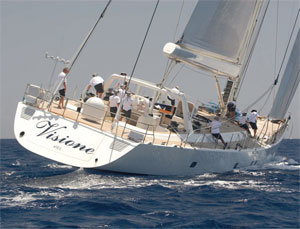
Even now, 20 years after her launch, the Baltic 147 Visione stands out as a remarkable technical achievement
The 80ft Midnight Sun was one of the first maxis with full composite construction, launched in 1982. ‘The forward part was a large, empty sail store and we used specially designed longitudinal bulkheads and framework in the upper corner between hull and deck to create the required stiffness,’ Johansson recalls.
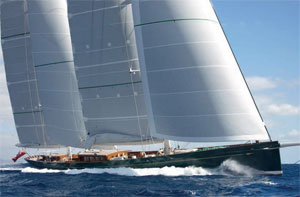
An exceptional project by any standards, launched in 2011, the 221ft LOA Hetairos is the largest carbon fibre yacht in the world and a true wolf in sheep’s clothing
The Baltic 43 Bully was the first offshore yacht built entirely in epoxy resin, in 1985. In technical terms this was a spin-off from an earlier R&D project, developing ultra-strong vacuum-infused sandwich laminates for a Soviet deep-sea submarine, which ruffled diplomatic feathers when the Americans found out about it. ‘The main unit was solid steel; we built a streamlined cover around the equipment,’ he says. ‘If you send a normal laminate down to 6,000m it will not be the same afterwards. We learned a few things from that project.’
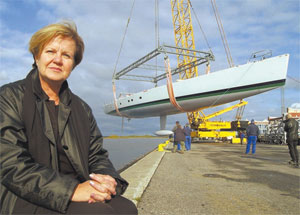
Lisbeth Staffans led Baltic from 1990, through many of its greatest achievements
In 1990, Baltic regained its independence. Finland’s industrial sector was in recession and Hollming needed to focus on its core business. ‘They asked us to arrange a management takeover,’ Johansson explains. ‘The yard was an important workplace for the local community and to shut it would have been very destructive. We were 32 employees who got together, took over and continued the business.’
Marketing manager Lisbeth Staffans stepped up to be managing director and led Baltic Yachts for two decades from a challenging start. ‘With a bad order book and uncertain future there were sleepless nights at the beginning of this new era,’ Johansson says. ‘Lisbeth was a very good person for that job. We couldn’t afford to make any mistakes and she made sure we didn’t. But this period is the one I’m most proud of. We did a good job, moved up in the size of our projects and stayed profitable.’
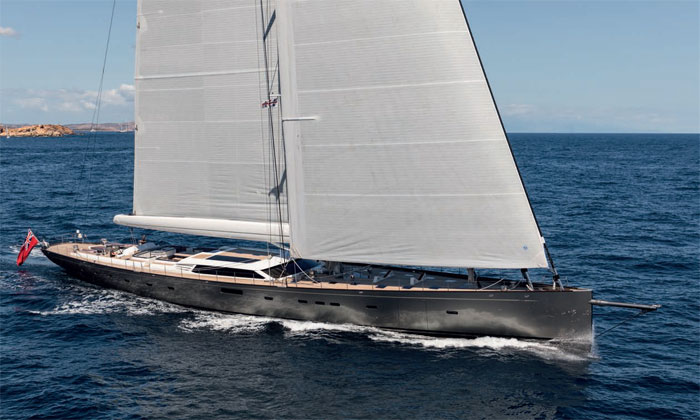
Delivered in 2017, the Baltic 175 Pink Gin IV is still the largest carbon composite sloop in the world with a mast 16m taller than a J Class
Innovation continued apace with production manager Christer Lill running a remarkably tight operation as the yachts ramped up rapidly in sophistication and size. In 1996 they launched 67ft Aledoa, the world’s first pre-preg carbon cruiser, and 87ft Anny – their first with a lifting keel, twin rudders and complex hydraulics. She had full push-button sail controls and a tender could be driven straight into the automatic opening-andlowering garage in her stern.
The following year, the Baltic 70 Vittfarne heralded a new style of yacht combining classic appearance and fine traditional craftsmanship with hitech construction, light displacement and modern hydrodynamics. ‘Bill Dixon’s team did a fantastic job on the design and our carpenters performed magic in building it,’ Johansson says.
Another Baltic 70, also launched in 1997, took carbon composite sandwich construction to a new level. The fully fitted interior of Loftfari was built almost entirely in prepreg carbon/ Nomex honeycomb as well as her hull and deck, saving a large amount of additional weight. It looked traditional, though, with thin veneers and fillets of teak covering all of the composite surfaces. Most Baltic yachts are now fitted out in a similar way.
The 78ft Super Baltic 5, delivered in 2000, was a major feat of engineering with a canting keel whose entire mechanism was installed in the shallow bilge beneath the saloon sole. She was calculated to be at least 3.5kts faster than an identical yacht with a fixed keel.
At the turn of the millennium Loftfari’s owner came back to Baltic with an impossible design brief, ‘or so it seemed at first,’ Johansson says. ‘To build a yacht in excess of 140ft capable of planing at 30kts or more.’ The project was an immense challenge, not least because their largest build up to then was a 97- footer. Two years of development work followed before the owner gave the green light for the build to proceed. Remarkably the yacht was delivered six months ahead of schedule and exceeded all expectations. Packed with unique innovations and with almost literally no expense spared, the Baltic 147 Visione was far ahead of her time and despite being 20 years old she is still quite capable of taking line honours in superyacht regattas today.
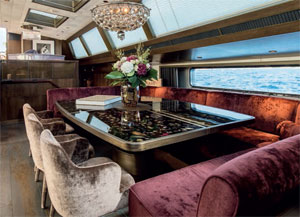
Pink Gin VI is impressively engineered and also a showcase of the shipyard’s world class interior fit-out skills
In build at the same time, the 141ft Canica challenged the yard in different ways. Performance was key but a lot of equipment and systems were also required to ensure a very high level of comfort on board. ‘That was the first yacht we built with a full floating interior,’ Baltic sales director Kenneth Nyfelt, son of founder Jan- Erik, explains. ‘We installed a highly complex Siemens PLC monitoring and control system, and it was the first project where we used noise and vibration consultants.’ With half the displacement of a typical 140ft cruising yacht, the performance targets were achieved and Canica can now be regarded as the first in a gradually evolving style of high-performance Baltic ‘super cruisers’ that continues to this day. A similar and parallel evolution of successful cruiser-racers began with Nilaya in 2010.
A stand-out project delivered in 2011, at 221ft LOA the Baltic 197 Hetairos is largest carbon composite sailing yacht in the world. A true wolf in sheep’s clothing with an incredible sail area : displacement ratio and a regular winner in superyacht regattas, the 60-metre ketch is classic on deck but thoroughly modern below the waterline with a unique lifting rudder as well as a lifting keel.
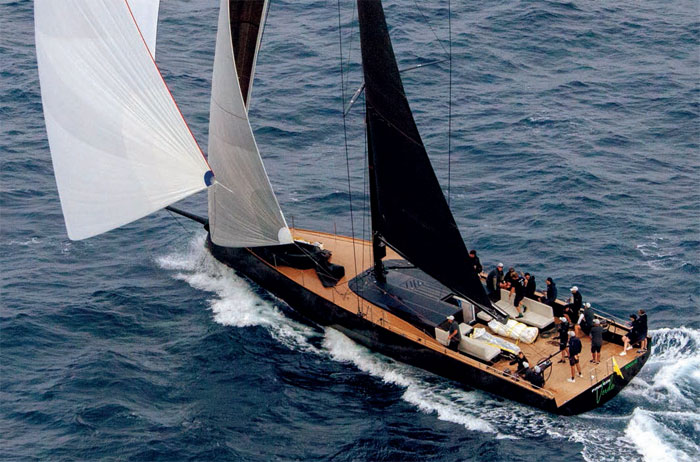
The new semi-custom Baltic 68 Café Racer. High performance has never been this easy to handle
Around this time, the people who had staged the 1990 management takeover began to retire so new owners were needed. Two local investors bought shares in 2010; three years later an 80 per cent stake in Baltic Yachts was acquired by the German family-owned company Otto Bock – led by Professor Hans Georg Näder, a longstanding client of Baltic Yachts – and its future was secured. Henry Hawkins, a yacht captain with vast practical experience including many thousands of ocean miles as skipper of Näder’s yachts, joined Baltic, taking on a large part of Johansson’s role.
Näder’s own 175ft Pink Gin VI is one of the most notable recent builds and currently the world’s largest carbon composite sloop with a rig 16m taller than a J Class. Her key features include fold-down platforms in her topsides just above the waterline that are large enough to walk through, one amidships in the main saloon and one forward in the owner’s suite. While relatively easy to build on a large motor yacht, putting large apertures in highly stressed parts of a sailing yacht hull without reducing its stiffness was a major engineering challenge, solved by mechanically locking the platforms firmly in place to become structural parts of the hull.
Another recent showcase of Baltic’s innovation is the 142ft Canova, which made headlines in 2019 as the world’s first superyacht with a DSS foil to reduce pitching and heeling, plus a host of other advanced features such as an immensely strong coachroof with a featherlight look and an electric drive system that provides enough regeneration capability under sail to cross the Atlantic without using any fossil fuel – with both sailing and hotel systems running. After four years of cruising, a wide range of what used to be bleeding-edge technologies are now proven to work reliably.
To mark Baltic Yachts’ 50th anniversary, the first Baltic 46 Queen Anne returned to the yard last spring for a refit. Two of the men who built her – Johansson and Jan-Erik Nyfelt, whose grandchildren now work at Baltic – were delighted to find her in excellent condition, which a survey duly confirmed. ‘No structural works are needed, the hull appendages are sound, as is the mast,’ Hawkins says. ‘It’s also interesting that the original propulsion setup was still operational and in good order. The enjoyment at our end was the size of everything compared to today, from fibre technology to deck fittings. There are 18 winches on that boat; a modern 100-footer uses just seven or eight!’ She will be relaunched in June after a cosmetic refit, with a new engine.
What direction is Baltic Yachts likely to take in the future? The 68ft cruiser-racer Pink Gin Verde might hold a few clues with its 50 per cent flax fibre hull and micro-turbine hybrid propulsion system, but as Baltic’s CEO Anders Kurtén puts it, ‘That all depends on where our customers want to take us.’
‘We are fortunate and honoured to build some of the most exciting, groundbreaking custom sailing yachts in the world which means the next major milestone will forever be the next launch, summer 2023 being a perfect example,’ he says. ‘My best guess for the future is ever increasing sustainable practices and yachts with diminishing lifecycle emissions, as well as quantum leaps in terms of pure sailing performance.’
Click here for more information on Baltic Yachts, »
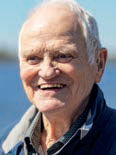 One of the key figures in the story of Baltic Yachts, co-founder Jan- Erik Nyfelt, passed away on 28 January. A highly respected senior foreman in the yard from 1973 to 2002 – and before that, one of the first employees at Nautor – he leaves an important legacy in Finland’s boatbuilding industry.
One of the key figures in the story of Baltic Yachts, co-founder Jan- Erik Nyfelt, passed away on 28 January. A highly respected senior foreman in the yard from 1973 to 2002 – and before that, one of the first employees at Nautor – he leaves an important legacy in Finland’s boatbuilding industry.We invite you to read on and find out for yourself why Seahorse is the most highly-rated source in the world for anyone who is serious about their racing.
To read on simply SIGN up NOW
Take advantage of our very best subscription offer or order a single copy of this issue of Seahorse.
Online at:
www.seahorse.co.uk/shop and use the code TECH20
Or for iPad simply download the Seahorse App at the iTunes store


